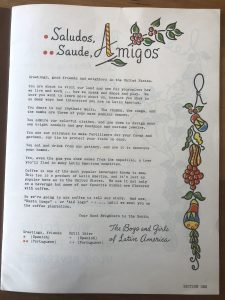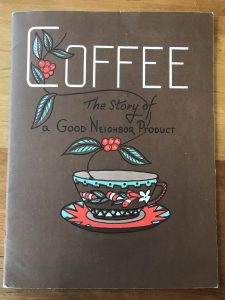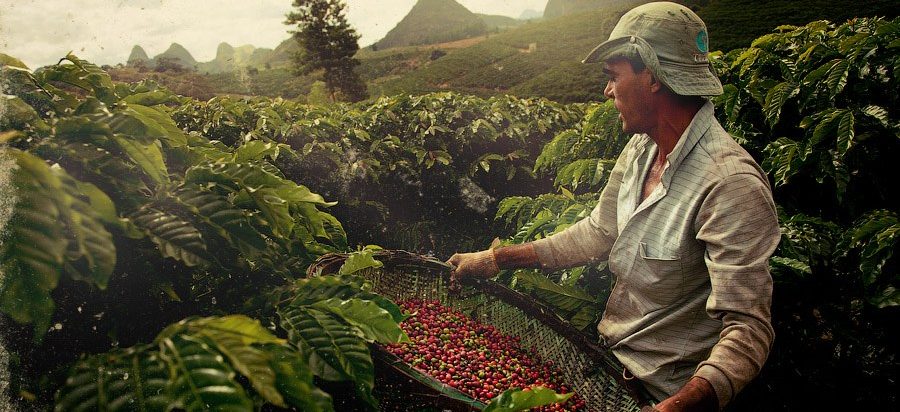Tate Harobin and Katharine Parnell
Professor Woo
FYS 143 – Coffee
11 October 2018![]()
![]()
![]()
Coffee plays a major part in the world’s history. Coffee first spread from Ethiopia to across the Red Sea due to trading with Arabs, then to Turkey, the East Indies, Europe, and then the Americas. Coffee has been used for many reasons throughout its’ history but has also been looked at as something poisonous by many people. When people were unaware of the bodily effects, coffee was made illegal for the thought that it was a beverage that would make people change into something who they were not. King Charles II of England banned coffeehouses in 1675 due to the fact that he believed that “coffeehouses disturbed the peace of the realm and promoted idleness and some scurrilous and defamatory rumor-mongering” (King Charles II). The Women’s Petition Against Coffee strictly fought for the coffee ban because they felt as if their husbands wore “greater breeches” and would get drunk only to soberize themselves with coffee, which would just drive their wives insane (Pendergrast 13). Despite the many effects and downfalls of coffee, consumers loved the beverage. By 1788, San Domingo supplied half of the worlds’ coffee supply which mean that there was a lot of forced labor amongst the civilians (Pendergrast 17). Coffee has created years worth of turmoil and mistreatment for the people of South America. “Workers were confined to the state-owned plantations and forced to work long hours for low wages” (Pendergrast 18). Coffee helped fuel the slave industry. The treatment of coffee farmers in South America has been overlooked for decades. While the pamphlet, Coffee, The Story of a Good Neighbor Product, depicts a happy relationship between workers in South America and in the United States, the books Uncommon Grounds: The History of Coffee and How it Transformed our World and Coffee – A Brief History, reveal the cynical truth of the treatment of coffee farmers in South America.
Coffee, The Story of a Good Neighbor Product, was created in 1966 by the Pan-American Coffee Bureau (Coffee & Eggs). Opening up to the first page of the pamphlet, the reader sees a greeting from the Boys and Girls Club of Latin America that will make it seem as if the United States and Latin America are friendly with one another. Quotes such as “good friends and neighbors in the United States” is meant to give the American reader a warm feeling about the pamphlet before they even begin to explore the rest of the object. The greeting letter does not only address coffee, it addresses that Americans dance to Latin American music, admire the bright and colorful clothing style that is often worn throughout Latin America, and use Latin American pottery to furnish and decorate their homes. The statements made in the greeting do not address the truth of what happens in Latin America. In fact, the Pan-American Coffee Bureau wanted this pamphlet to tell the story of the supposed “lavish” lifestyle that Latin Americans live on the plantations. This pamphlet only shows the bright side of coffee history, such as the coffee plant itself, preparation and roasting in the United States, and how important coffee is to Latin America.
States” is meant to give the American reader a warm feeling about the pamphlet before they even begin to explore the rest of the object. The greeting letter does not only address coffee, it addresses that Americans dance to Latin American music, admire the bright and colorful clothing style that is often worn throughout Latin America, and use Latin American pottery to furnish and decorate their homes. The statements made in the greeting do not address the truth of what happens in Latin America. In fact, the Pan-American Coffee Bureau wanted this pamphlet to tell the story of the supposed “lavish” lifestyle that Latin Americans live on the plantations. This pamphlet only shows the bright side of coffee history, such as the coffee plant itself, preparation and roasting in the United States, and how important coffee is to Latin America.
The creators of this pamphlet made sure that the audience would have an unknown biased opinion about coffee plantations. The Pan-American Coffee Bureau is an American org![]() anization, therefore they want the audience to see nothing but the bright side from the coffee growers. This form of propaganda was made so that the consumers of coffee products will keep purchasing the goods from major coffee companies, which inevitably helped to fuel the economy in both Latin America and the United States. If the audience were to discover the heinous truth behind coffee plantations, they would not purchase nearly as much coffee. This pamphlet is for
anization, therefore they want the audience to see nothing but the bright side from the coffee growers. This form of propaganda was made so that the consumers of coffee products will keep purchasing the goods from major coffee companies, which inevitably helped to fuel the economy in both Latin America and the United States. If the audience were to discover the heinous truth behind coffee plantations, they would not purchase nearly as much coffee. This pamphlet is for  consumers to see and read. More specifically, this pamphlet is for families. Towards the last few pages, the reader could see an activity section for them to complete. These activities include picture studies, map work, a sewing project, art study, and a language section. For many families, this pamphlet would be read at the breakfast table where kids will be able to do some of the activities sections and learn about Latin America with their family members. Not only does this bring the family together, but it attaches a sense of humanity to the coffee that is consumed by the family. Once coffee becomes more than just a caffeinated beverage and becomes something where people can attach comfort to, the industry will begin to soar.
consumers to see and read. More specifically, this pamphlet is for families. Towards the last few pages, the reader could see an activity section for them to complete. These activities include picture studies, map work, a sewing project, art study, and a language section. For many families, this pamphlet would be read at the breakfast table where kids will be able to do some of the activities sections and learn about Latin America with their family members. Not only does this bring the family together, but it attaches a sense of humanity to the coffee that is consumed by the family. Once coffee becomes more than just a caffeinated beverage and becomes something where people can attach comfort to, the industry will begin to soar.
Peet’s Coffee opened in 1966 in Berkeley, California (History of Coffee). During this time period, the coffee industry was picking up in the United States. Peet’s Coffee originally sold dark roasted Arabica beans from Ethiopia and did not, in fact, sell actual coffee. The beans were made in small batches, and was originally made to bring better quality coffee into the American coffee market (Peet’s Coffee). At the time, most people knew that coffee came from Ethiopia. There was not a lot of knowledge about the origins of different coffee beans, so this pamphlet was designed to help educate readers about the cultivation of coffee in Latin America. The activities such as the map study helps the reader learn exactly where their coffee is coming from and the plantation helps to show the reader that the coffee growers are enjoying their lives on the plantation. The Pan-American Coffee Bureau wanted to boost business in Latin America and therefore created these pamphlets to show a happy relationship between Latin America and the United States, make the consumers feel as if they are buying a product that was made with love, and to help educate consumers about where their coffee comes from.
Uncommon Grounds: The History of Coffee and How it Transformed our World is a book written by Mark Pendergrast. Uncommon Grounds tells the story of coffee from the plants discovery in the 11th century to rise of Starbucks and the “third wave”. It’s important to note that there does not seem to be an hidden agenda behind the Pendergrast’s writing. Although bias is innately present, Pendergrast bases his accusations and analysis off reputable sources. From a reader’s perspective it seems Pendergrast’s writing can be trusted. Uncommon Grounds touches upon many facets of the coffee industry and extensively discusses coffees history. One common thread that keeps appearing in Uncommon Grounds is labor in the coffee industry. Due to the labor intensive process required to cultivate the coffee bean, many livelihoods depend on the coffee industry.
A French traveler of the 18th century stated: “I do not know if coffee and sugar are essential to the happiness of Europe, but I know well that these two products have accounted for the unhappiness of two great regions of the world (America & Africa)”(Pendergrast 17). This quote touches upon the love-hate relationship of coffee and labor depicted in Uncommon Grounds. Pendergrast is keen to harp on the fact that although coffee has advanced societies, played pivotal cultural roles and created prosperity for many people and countries, it has also caused, and is still causing, unimaginable hardship for countless others. Pendergrast notes that in developing countries like Ethiopia and Guatemala, economies boomed of coffee as it became their main export, but not everyone equally benefited. While governments, warlords, business leaders and colonial rulers prospered, laborers, who were in many instances slaves, lives worsened. Throughout history laborers in the coffee industry have endured many hardships. As a slave working on a coffee farm recounts the treatment himself and others experienced, “Have they not hung men with heads downward, drowned them in sacks, crucified them on planks, buried them alive, crushed them in mortars? Have they not forced them to eat shit?”(Pendergrast 17-18). Unfortunately, this slave recount is similar to many others.
Uncommon Grounds gives many primary accounts from insiders in the coffee industry, all talking about the the industries cruelty and pitfalls. Although many insider accounts are mentioned, Pendergrast is keen to add multiple outside perspectives such as an account of Dutch civil servant Eduard Douwes Dekker who served in Java: “Strangers came from the West who made themselves lords of his (the natives) land, forcing him to grow coffee for pathetic wages…Only a few years ago, whole districts died of starvation. Mothers offered their children for sale to obtain food. Mothers ate their children”(Pendergrast 18). Although all these negative accounts may lead some to believe that coffee is the root of all evil, Pendergrast adds that the fault does not lie with the product but rather with those who run the operations. This poor treatment of laborers occurs in nearly every producing country. Domingo, a Guatemalan coffee plantation worker was thrown in jail after attempting to flee the farm because, “she was sold by her own father”(36). Uncommon Grounds also highlights sexual exploitations faced by women in the coffee industry. The end of the book is the only place where positively, regarding labor in the coffee industry, can be found. Pendergrast notes that many jobs were created by the arising popularity of cafes and the beverage in general. Uncommon Grounds leaves readers feeling properly informed about labor in the coffee. Even though Pendergrast’s writing may come off as pessimistic, corners aren’t cut and not much appears to be left out. Overall, Pendergrast discusses the coffee industry in a very critical and truthful light.
Coffee: A Brief History written by Ina Baghdiantz McCabe(Tufts University), is a shorter paper that follows coffees history while focusing on societies’ viewpoints and the social aspect of the drink. The bibliography consists of reputable sources and McCabe’s writing style is very factual. This paper seems to be a trustworthy source. Differing from Pendergrast, McCabe does not nearly place as much emphasis on Labor in the Coffee industry. Being that this nowhere near the length of Pendergrast, McCabe is not ignoring labor but rather focusing on other aspects of the coffee industry. Albeit McCabe does speak of the Labor industry in a negative light, it is nowhere near to the degree of Pendergrast. While Pendergrast would give grueling first person accounts of the awful conditions, McCabe merely acknowledged them: “Labor on a coffee plantation was backbreaking and baldy remunerated. If workers,.. Were paid at the rate of 15s a month, the cost of food provisions (were) 12s.”(McCabe) McCabe forces readers to draw more of their own conclusions regarding the severity of the work. McCabe does cite statistics and go into a bit further detail later in the paper. An example of this is when McCabe talks about malnutrition in El Salvador: “malnutrition affected 45% of children in coffee-growing households”(McCabe) McCabe is just laying out facts about the conditions and not going into much detail. Pendergrast would of most likely gone into further description of this hunger and really paint a picture in readers minds of what it looked liked. Although the authors writing styles drastically differ, both readings effectively and appropriately acknowledge the hardships laborers endured while working in the coffee industry.
Coffee (The Story of a Good Neighbor Product) is a written by The Boys and Girls of Latin America as they refer to themselves as. It was published in 1949 and distributed out of New York City. The very  first page opens with: “Greetings, good friends and neighbors in the United States”(Coffee 1) and ends with: “Your Good Neighbors to the South”(Coffee 1). It’s target audience is clearly the US. There is an activity section in the back section which leads me to believe that it is also aimed at a younger crowd, possibly 14-30. The booklet blatantly states that it’s purpose is to educate Americans about the coffee industry. Due to the fact their are motives behind the writing, it is important to take into account and acknowledge that bias is most likely present while reading this booklet.
first page opens with: “Greetings, good friends and neighbors in the United States”(Coffee 1) and ends with: “Your Good Neighbors to the South”(Coffee 1). It’s target audience is clearly the US. There is an activity section in the back section which leads me to believe that it is also aimed at a younger crowd, possibly 14-30. The booklet blatantly states that it’s purpose is to educate Americans about the coffee industry. Due to the fact their are motives behind the writing, it is important to take into account and acknowledge that bias is most likely present while reading this booklet.
Coffee does not mention the hardships of labor or even give the slightest connotation that working and living conditions in the coffee industry are poor. Coffee states that large scale farms, also known as fazendas, are, “ practically a little community in itself”(Coffee 5), Coffee notes due to large number of workers the owner provides, “a place to live in, a church, a meeting place and a school for the children… they must have a place to hold their fiestas. So that to must be provided as well”(Coffee 5). From the reader’s perspective, the owners come off as kind and caring. Furthermore, the lack of in-depth details of these building and aesthetically pleasing illustrates, lead one to believe that these facilities are sufficient and possibly even enjoyable. Additionally, Coffee goes as far as to compare a fazenda to an American town, “it isn’t hard to see how the coffee plantation is to the Latin American what our little suburban town is a North American”(Coffee 5). By comparing fazendas to American towns, Coffee is trying to cause readers to conclude that life on a coffee plantation in South America is not much different from back home. Deeper in the booklet their is page which explains with visuals the wet and dry method of preparing the beans. This merly explains the two processes and does not go into detail about the laborers. In the visuals, workers are depicted as stick figures. By depicting them as stick figures we naturally do not attach any innate human emotions or feelings toward the workers. Whether this is intentional or not it can make us forget the laborers behind these processes. Coffee portrays labor in the coffee industry very positively and with facts, with the lack of details present, it is easy to assume that life as plantation worker is great.
Uncommon Grounds, Coffee: A Brief History and Coffee all discuss different aspects of labor and display them in different lights. Uncommon Grounds and Coffee have completely different viewpoints on Labor. While neither books are lying or falsify information Coffee is omitting the poor working and living conditions of workers. This is purposeful because the Latin American coffee industry is reliant on American consumerism and wants Americans to have positive thoughts about where they get their coffee. Also through comparison it seems that Uncommon Grounds solely focuses on the hardships endured by laborers in the coffee industry and doesn’t touch upon their life outside work or discuss any benefits the coffee industry provides to workers as Coffee does. Coffee: A Brief History comes off as the most unbiased source and it’s depiction of labor lies between Uncommon Grounds and Coffee. While it does acknowledge that working conditions were poor it does not harp on them like Uncommon Grounds or ignore them like Coffee. Coffee: A Brief History was written by a scholarly source, a professor, so the book is accepted as trustworthy. Ultimately, the differences in the three books stem from different goals of the authors and their writing styles. The comparison of the three has taught me to not rely on one source for information, and look for bias and motives the author may have.
Works Cited:
- Avey, Tori. “The Caffeinated History of Coffee.” PBS, Public Broadcasting Service, 8 Apr. 2013, www.pbs.org/food/the-history-kitchen/history-coffee/.
- “Coffee & Eggs.” Coffee & Eggs, ga2so.com/coffee.php.
- “King Charles II Of England Banned Coffeehouses In 1675.” Ancient Pages, 18 June 2018, www.ancientpages.com/2018/06/18/king-charles-ii-of-england-banned-coffeehouses-in-1675/.
- McCabe, Ina Baghdiantz Baghdiantz. Coffee: A Brief History. Tufts University, 2012.
- “Our Platform.” Coffee Bureau, www.coffeebureau.co/platform/.
- Pendergrast, Mark. Uncommon Grounds: The History of Coffee and How It Transformed Our World. Basic Books, 2018.




 eine on a daily basis. While most of this comes from soda, coffee is becoming more prevalent in children’s diets. A study published in the Journal of Human Lactation studied toddlers in Boston and found that by the time children reached the age of two, more than fifteen percent were consuming coffee. Of these children, fifteen percent were consuming a half cup each day.
eine on a daily basis. While most of this comes from soda, coffee is becoming more prevalent in children’s diets. A study published in the Journal of Human Lactation studied toddlers in Boston and found that by the time children reached the age of two, more than fifteen percent were consuming coffee. Of these children, fifteen percent were consuming a half cup each day.



 States” is meant to give the American reader a warm feeling about the pamphlet before they even begin to explore the rest of the object. The greeting letter does not only address coffee, it addresses that Americans dance to Latin American music, admire the bright and colorful clothing style that is often worn throughout Latin America, and use Latin American pottery to furnish and decorate their homes. The statements made in the greeting do not address the truth of what happens in Latin America. In fact, the Pan-American Coffee Bureau wanted this pamphlet to tell the story of the supposed “lavish” lifestyle that Latin Americans live on the plantations. This pamphlet only shows the bright side of coffee history, such as the coffee plant itself, preparation and roasting in the United States, and how important coffee is to Latin America.
States” is meant to give the American reader a warm feeling about the pamphlet before they even begin to explore the rest of the object. The greeting letter does not only address coffee, it addresses that Americans dance to Latin American music, admire the bright and colorful clothing style that is often worn throughout Latin America, and use Latin American pottery to furnish and decorate their homes. The statements made in the greeting do not address the truth of what happens in Latin America. In fact, the Pan-American Coffee Bureau wanted this pamphlet to tell the story of the supposed “lavish” lifestyle that Latin Americans live on the plantations. This pamphlet only shows the bright side of coffee history, such as the coffee plant itself, preparation and roasting in the United States, and how important coffee is to Latin America. consumers to see and read. More specifically, this pamphlet is for families. Towards the last few pages, the reader could see an activity section for them to complete. These activities include picture studies, map work, a sewing project, art study, and a language section. For many families, this pamphlet would be read at the breakfast table where kids will be able to do some of the activities sections and learn about Latin America with their family members. Not only does this bring the family together, but it attaches a sense of humanity to the coffee that is consumed by the family. Once coffee becomes more than just a caffeinated beverage and becomes something where people can attach comfort to, the industry will begin to soar.
consumers to see and read. More specifically, this pamphlet is for families. Towards the last few pages, the reader could see an activity section for them to complete. These activities include picture studies, map work, a sewing project, art study, and a language section. For many families, this pamphlet would be read at the breakfast table where kids will be able to do some of the activities sections and learn about Latin America with their family members. Not only does this bring the family together, but it attaches a sense of humanity to the coffee that is consumed by the family. Once coffee becomes more than just a caffeinated beverage and becomes something where people can attach comfort to, the industry will begin to soar.  first page opens with: “Greetings, good friends and neighbors in the United States”(Coffee 1) and ends with: “Your Good Neighbors to the South”(Coffee 1). It’s target audience is clearly the US. There is an activity section in the back section which leads me to believe that it is also aimed at a younger crowd, possibly 14-30. The booklet blatantly states that it’s purpose is to educate Americans about the coffee industry. Due to the fact their are motives behind the writing, it is important to take into account and acknowledge that bias is most likely present while reading this booklet.
first page opens with: “Greetings, good friends and neighbors in the United States”(Coffee 1) and ends with: “Your Good Neighbors to the South”(Coffee 1). It’s target audience is clearly the US. There is an activity section in the back section which leads me to believe that it is also aimed at a younger crowd, possibly 14-30. The booklet blatantly states that it’s purpose is to educate Americans about the coffee industry. Due to the fact their are motives behind the writing, it is important to take into account and acknowledge that bias is most likely present while reading this booklet.


